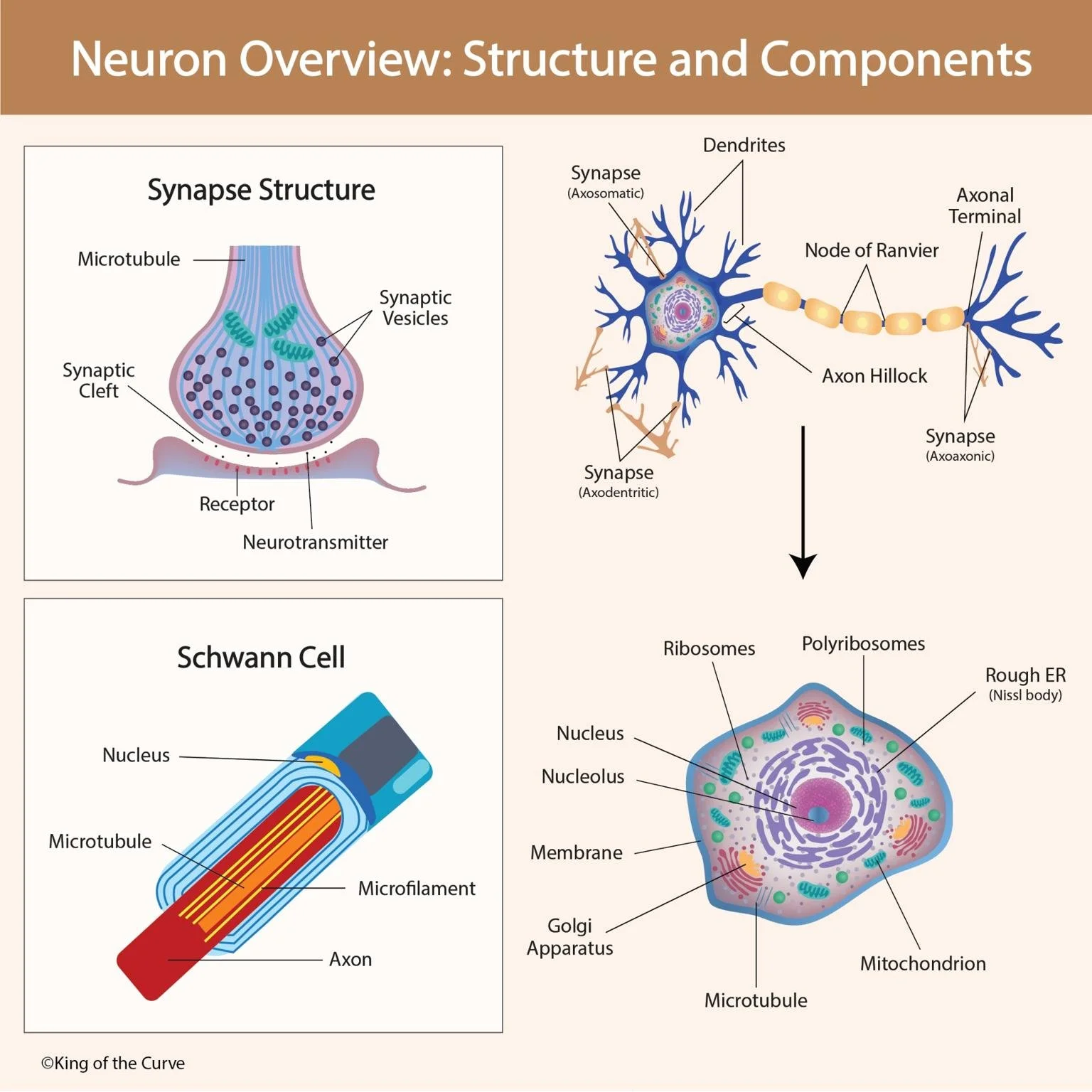🧠 Neuron Overview: Structure and Components
Neurons are the fundamental building blocks of the nervous system, responsible for transmitting information through electrical and chemical impulses. Understanding the anatomy of a neuron provides key insight into how the brain communicates with the body — a concept often tested on MCAT, USMLE, and NCLEX exams.
⚡ The Neuron and Its Core Regions
Each neuron has three main parts: the cell body (soma), dendrites, and axon.
Dendrites receive incoming signals from other neurons.
The soma houses the nucleus, nucleolus, Golgi apparatus, and Rough ER (Nissl bodies), supporting cell metabolism and neurotransmitter production.
The axon conducts impulses away from the soma to the axon terminal, where neurotransmitters are released to communicate with other neurons.
🔁 Synapse Structure and Signal Transmission
Communication between neurons occurs at the synapse a specialized junction that converts electrical impulses into chemical messages.
Synaptic vesicles release neurotransmitters into the synaptic cleft, which bind to receptors on the target neuron.
This process ensures precise regulation of neuronal signaling across various brain regions.
🧬 Schwann Cells and Myelination
In the peripheral nervous system (PNS), Schwann cells wrap around axons to form the myelin sheath, a fatty layer that increases conduction speed.
The signal jumps between Nodes of Ranvier through saltatory conduction, allowing rapid communication between neurons.
Damage to myelin can cause neurological disorders such as Guillain-Barré syndrome, often featured in neurophysiology exam questions.
🧩 Neuronal Components at a Glance
Below is a summary table that outlines key neuronal structures and their primary functions:
| Component | Location | Function |
|---|---|---|
| Dendrites | Extending from soma | Receive and transmit signals to the cell body |
| Cell Body (Soma) | Central region | Contains nucleus and organelles; integrates input |
| Axon | Extends from axon hillock | Carries impulses away from the neuron |
| Myelin Sheath (Schwann Cells) | Surrounding axon (PNS) | Speeds up electrical transmission |
| Synapse | Junction between neurons | Site of neurotransmitter release and signal exchange |
| Nissl Bodies (Rough ER) | Within soma | Synthesizes proteins and neurotransmitters |
🧩 Cellular Machinery and Exam Relevance
The neuron’s internal structure from ribosomes to microtubules ensures it functions as a highly specialized communication cell. The Golgi apparatus packages neurotransmitters, while mitochondria provide the energy needed for transmission.
For MCAT or Step 1 review, focus on how neuronal polarity, ion channel function, and myelination affect signal direction and speed. These are common concepts in neurobiology and physiology passages.
🧠 Final Thoughts
Neurons represent one of the most complex and efficient signaling systems in biology. From the synapse to the Schwann cell, each structure plays a vital role in maintaining homeostasis and information flow. A deep understanding of neuronal anatomy strengthens your foundation in neuroscience, psychology, and medical physiology key areas for exam success.
Frequently Asked Questions (FAQs)
-
Aim for 4-6 focused hours, ensuring you incorporate breaks to avoid burnout.
-
Practice mindfulness techniques, take practice exams under realistic conditions, and maintain a balanced lifestyle.
-
Set short-term goals, seek support from mentors, and reward yourself for small achievements.
-
Regular exercise improves focus, reduces stress, and enhances overall mental clarity.
-
KOTC offers personalized learning tools, gamification features, and adaptive question banks to help students stay on track without burnout.


